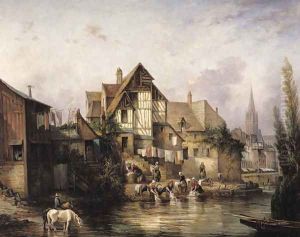Victor Theophile Tesniere Paintings
Victor Théophile Tésnière was a lesser-known French artist born in 1849. Not much information is widely available about his life and work, as he did not gain the same level of fame as some of his contemporaries. During his lifetime, the art world was experiencing a great deal of change, with the Impressionist movement challenging the traditional academic art that had dominated the French art scene.
Tésnière would have been a contemporary to the likes of Claude Monet, Edgar Degas, and Édouard Manet. However, unlike these artists, Tésnière did not become a leading figure in the art world. His works, if they followed the trends of the time, might have included traditional landscapes, portraits, or genre scenes, possibly exhibiting in the Paris Salon, which was the official art exhibition of the Académie des Beaux-Arts in Paris.
Despite the lack of widespread recognition, Tésnière's work would have contributed to the rich tapestry of 19th-century French art. He lived through significant historical events, such as the Franco-Prussian War and the transformation of Paris under Baron Haussmann, which were influential to the art and culture of the period.
Tésnière passed away in 1918, which was the final year of World War I—a time that marked the end of an era and the beginning of significant social and political changes in Europe. His death might have gone largely unnoticed in the art world, overshadowed by the dramatic events of the time and the emergence of new art movements like Dadaism and Surrealism that were beginning to take hold.
As with many artists of the time whose fame did not endure, Tésnière's work may be preserved in private collections or regional museums. Art historians might come across his pieces in the course of their research, bringing to light the role of artists like him in shaping the visual culture of their day.
